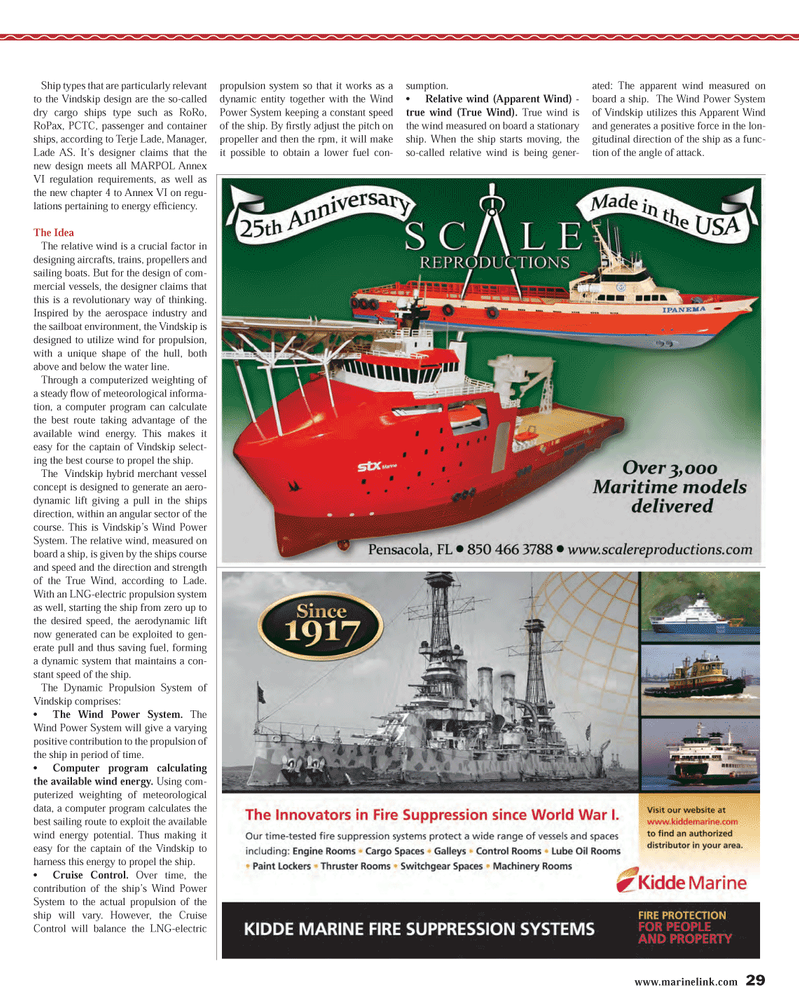
Page 29: of Maritime Reporter Magazine (October 2013)
Marine Design & Construction
Read this page in Pdf, Flash or Html5 edition of October 2013 Maritime Reporter Magazine
www.marinelink.com 29Ship types that are particularly relevant to the Vindskip design are the so-called dry cargo ships type such as RoRo, RoPax, PCTC, passenger and container ships, according to Terje Lade, Manager, Lade AS. It?s designer claims that the new design meets all MARPOL Annex VI regulation requirements, as well as the new chapter 4 to Annex VI on regu- lations pertaining to energy ef Þ ciency. The IdeaThe relative wind is a crucial factor in designing aircrafts, trains, propellers and sailing boats. But for the design of com-mercial vessels, the designer claims that this is a revolutionary way of thinking. Inspired by the aerospace industry and the sailboat environment, the Vindskip is designed to utilize wind for propulsion, with a unique shape of the hull, both above and below the water line. Through a computerized weighting of a steady ß ow of meteorological informa- tion, a computer program can calculate the best route taking advantage of the available wind energy. This makes it easy for the captain of Vindskip select- ing the best course to propel the ship. The Vindskip hybrid merchant vessel concept is designed to generate an aero-dynamic lift giving a pull in the ships direction, within an angular sector of the course. This is Vindskip?s Wind Power System. The relative wind, measured on board a ship, is given by the ships course and speed and the direction and strength of the True Wind, according to Lade. With an LNG-electric propulsion system as well, starting the ship from zero up to the desired speed, the aerodynamic lift now generated can be exploited to gen-erate pull and thus saving fuel, forming a dynamic system that maintains a con-stant speed of the ship. The Dynamic Propulsion System of Vindskip comprises: ? The Wind Power System. The Wind Power System will give a varying positive contribution to the propulsion of the ship in period of time. ? Computer program calculating the available wind energy. Using com-puterized weighting of meteorological data, a computer program calculates the best sailing route to exploit the available wind energy potential. Thus making it easy for the captain of the Vindskip to harness this energy to propel the ship. ? Cruise Control. Over time, the contribution of the ship?s Wind Power System to the actual propulsion of the ship will vary. However, the Cruise Control will balance the LNG-electric propulsion system so that it works as a dynamic entity together with the Wind Power System keeping a constant speed of the ship. By Þ rstly adjust the pitch on propeller and then the rpm, it will make it possible to obtain a lower fuel con-sumption. ? Relative wind (Apparent Wind) - true wind (True Wind). True wind is the wind measured on board a stationary ship. When the ship starts moving, the so-called relative wind is being gener- ated: The apparent wind measured on board a ship. The Wind Power System of Vindskip utilizes this Apparent Wind and generates a positive force in the lon-gitudinal direction of the ship as a func-tion of the angle of attack. MR #10 (26-33).indd 29MR #10 (26-33).indd 2910/2/2013 4:02:25 PM10/2/2013 4:02:25 PM

 28
28

 30
30
